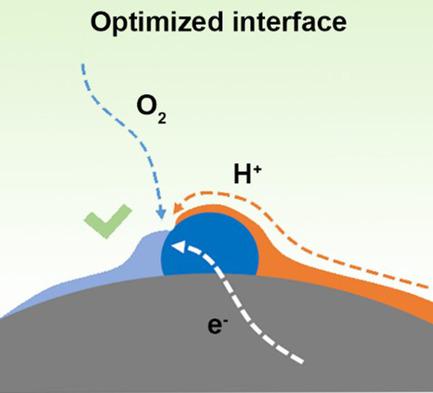当前位置:
X-MOL 学术
›
Energy Technol.
›
论文详情
Our official English website, www.x-mol.net, welcomes your
feedback! (Note: you will need to create a separate account there.)
Electrochemical Interface Optimization toward Low Oxygen Transport Resistance in High‐Temperature Polymer Electrolyte Fuel Cells
Energy Technology ( IF 3.6 ) Pub Date : 2020-07-14 , DOI: 10.1002/ente.202000085 Wei Xiao 1, 2, 3 , Zhangxun Xia 1, 3 , Huanqiao Li 1, 3 , Ruili Sun 1, 2, 3 , Suli Wang 1, 3 , Gongquan Sun 1, 3
Energy Technology ( IF 3.6 ) Pub Date : 2020-07-14 , DOI: 10.1002/ente.202000085 Wei Xiao 1, 2, 3 , Zhangxun Xia 1, 3 , Huanqiao Li 1, 3 , Ruili Sun 1, 2, 3 , Suli Wang 1, 3 , Gongquan Sun 1, 3
Affiliation

|
Due to the enhanced tolerance of CO‐containing species under elevated operation temperature around 150–220 °C, high‐temperature polymer electrolyte fuel cells (HT‐PEFCs) have drawn extensive interest in the recent decades. One of the major challenges remaining for HT‐PEFCs is the inferior cell performance ascribed to poor catalytic activity and mass transport, which are mainly determined by the electrochemical interface structure involving phosphoric acid electrolyte. Herein, the electrochemical interfaces are investigated and optimized by adjusting the hydrophilic phases within the catalyst layer (CL) to modulate phosphoric acid redistribution in the cathode. The electrochemical surface area and interfacial oxygen transport resistance in the CL are optimized by balancing the coverage of polytetrafluoroethylene (PTFE) and phosphoric acid on the catalyst surface, thus achieving an enhanced cell performance of the HT‐PEFC of up to 328.12 mW cm−2. This balancing strategy for optimizing the electrochemical interfacial structure could shed light on the development of electrode architecture design for energy conversion and storage devices.
中文翻译:

高温聚合物电解质燃料电池中低氧输运阻力的电化学界面优化
由于在大约150-220°C的高温下提高了含CO物质的耐受性,因此在最近几十年中,高温聚合物电解质燃料电池(HT-PEFC)引起了广泛的关注。HT-PEFCs仍然面临的主要挑战之一是由于不良的催化活性和传质而导致电池性能不佳,这主要是由涉及磷酸电解质的电化学界面结构决定的。在此,通过调节催化剂层(CL)内的亲水相以调节阴极中磷酸的重新分布来研究和优化电化学界面。−2。这种优化电化学界面结构的平衡策略可以为能量转换和存储设备的电极体系结构设计的发展提供启示。
更新日期:2020-09-05
中文翻译:

高温聚合物电解质燃料电池中低氧输运阻力的电化学界面优化
由于在大约150-220°C的高温下提高了含CO物质的耐受性,因此在最近几十年中,高温聚合物电解质燃料电池(HT-PEFC)引起了广泛的关注。HT-PEFCs仍然面临的主要挑战之一是由于不良的催化活性和传质而导致电池性能不佳,这主要是由涉及磷酸电解质的电化学界面结构决定的。在此,通过调节催化剂层(CL)内的亲水相以调节阴极中磷酸的重新分布来研究和优化电化学界面。−2。这种优化电化学界面结构的平衡策略可以为能量转换和存储设备的电极体系结构设计的发展提供启示。











































 京公网安备 11010802027423号
京公网安备 11010802027423号